Scientific name Genetta | ||
 | ||
Lower classifications Similar Aquatic genet , Giant forest genet , Common genet | ||
A genet (pronounced /ˈDʒɛNɪT/ or /dʒəˈnɛt/) is a member of the genus Genetta, which consists of 14 to 17 species of small African carnivorans. Genet fossils from the Pliocene have been found in Morocco. The Common genet is the only genet present in Europe and occurs in the Iberian Peninsula and France.
Contents
- Taxonomy
- Characteristics
- Distribution and habitat
- Ecology and behavior
- Threats
- Etymology
- Pet genets
- References
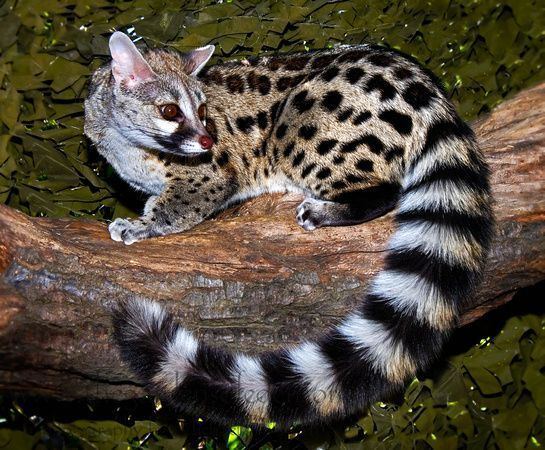
Taxonomy
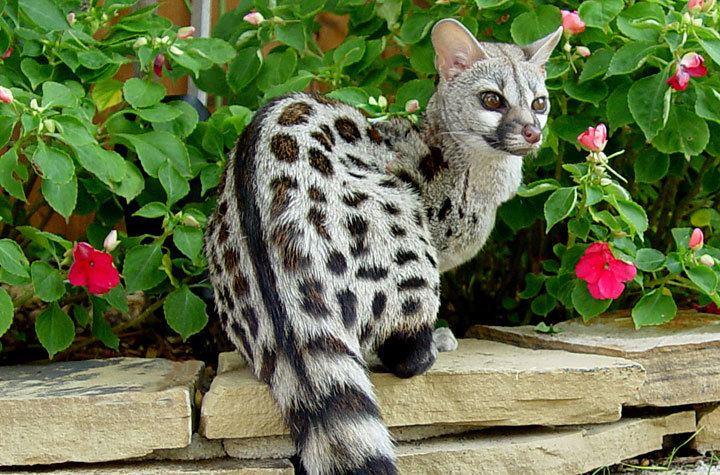
Genetta was named and described by Cuvier in 1817. The number of species in the genus is controversial. The following were proposed as valid in 2005:
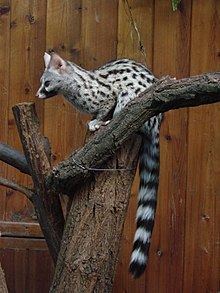
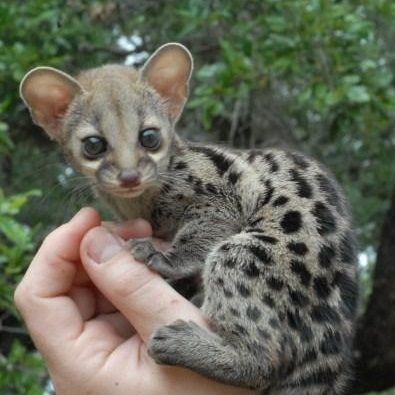
Genetta and Poiana are estimated to have diverged about 9.5–13.3 million years ago. Genetta species are estimated to have diverged at least 8.5 million years ago starting with G. thierryi, followed by G. victoriae 3.98–6.01 million years ago.
Characteristics
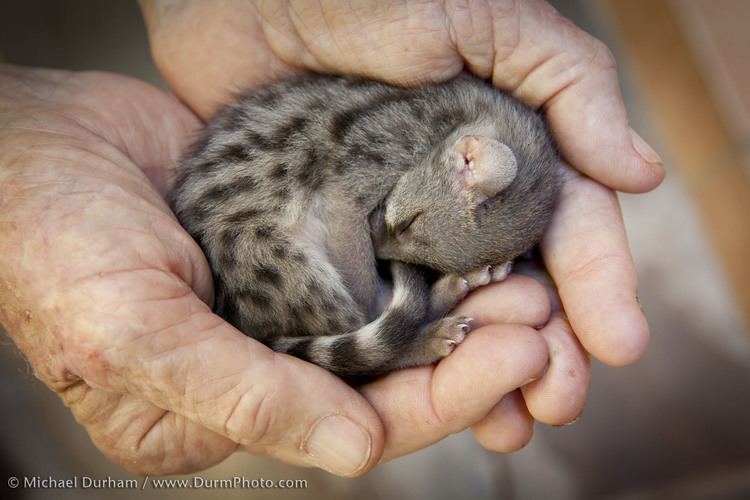
Genets are slender cat-like animals with a long body, a long ringed tail, large ears, a pointed muzzle and partly retractile claws. Their fur is spotted, but melanistic genets have also been recorded. They have musk glands and anal sacs.
All genet species have a dark stripe along the spine; they differ in fur color and spot pattern. Their size varies between species from 40.9 to 60 cm (16.1 to 23.6 in) in head-to-body length with 40 to 47 cm (16 to 19 in) long tails; their tails are almost as long as head and body. They have large eyes with elliptical pupils; the iris is about the color of the fur. They can move their eyes within their sockets to a limited extent, and move their heads to focus on moving objects. Their ear pinnae have a fine layer of hair inside and outside. They can move the pinnae by about 80° from pointing forward to the side, and also from an erect position to pointing downwards. Their wet nose is important for both sensing smell and touch.
Distribution and habitat
All genet species are indigenous to Africa. The common genet was introduced to southwestern Europe during historical times. It was brought from Maghreb to the Mediterranean region as a domestic animal about 1000 to 1500 years ago, and from there spread to southern France and Italy. In Africa, it is found in wooded habitats north of the Sahara, in savanna zones south of the Sahara to southern Africa and along the coast of Arabia, Yemen and Oman.
The Cape genet is endemic to fynbos, grassland and coastal forests in South Africa.
The South African small-spotted genet lives in woodland savannah, grassland, thickets, dry vlei areas in Angola, Namibia, South Africa and Zambia.
The Rusty-spotted genet is widely distributed in sub-Saharan woodland savannah, savannah-forest mosaic, rain forest and montane forest up to an elevation of 3,400 m (11,200 ft) in Ethiopia.
The Pardine genet lives in primary and secondary rainforests, gallery forests, moist woodlands, but also in plantations and suburban areas ranging from Senegal to the Volta River in Ghana.
The Abyssinian genet has been recorded in montane dry forest up to 3,750 m (12,300 ft) in Ethiopia.
The King genet is restricted to rainforest in the Congo Basin, Bioko Island, Ghana and Liberia.
The servaline genet lives in Central African lowland forests to high-altitude bamboo forest and coral rag thicket on Zanzibar.
The Angolan genet inhabits open miombo forest from Angola to central Tanzania.
The giant forest genet lives in rainforests of the Democratic Republic of the Congo and western Uganda
The Haussa genet inhabits savannah and moist woodlands in West Africa.
G. letabae has been recorded from woodland savannah in Lesotho, Swaziland, Mozambique, Namibia and South Africa.
Johnston's genet inhabits dense rainforest in Upper Guinea.
The aquatic genet inhabits rainforests between the Congo River and the Rift Valley.
The Crested servaline genet is endemic to Nigeria and Cameroon, where it inhabits scrub and primary deciduous forests.
Schouteden’S genet inhabits rainforest, woodland savannah and savannah-forest mosaic in tropical Africa.
Bourlon's genet lives only in the Upper Guinean rainforests in West Africa.
Ecology and behavior
Genets are highly agile, have quick reflexes and exceptional climbing skills. They are the only viverrids able to stand on their hind legs. They walk, trot, run, climb up and down trees, and jump. They live on the ground, but also spend much of their time in trees. They are considered solitary, except during mating and when females have offspring.
They are omnivorous and opportunistically catch invertebrates, small vertebrates, but also feed on plants and fruit. Aquatic genets feed mainly on fish. Angolan genets are thought to feed on grasshoppers and arthropods. Johnston's genet probably feeds mainly on insects.
In 2014, a camera trap in the Hluhluwe–iMfolozi Park captured a large spotted genet riding on the back of two different buffalo and a rhinoceros. This was the first time a genet was recorded hitch-hiking.
Females have up to five young in a litter. They are known to rear their young alone.
Common genet females become sexually mature at the age of two years. Once copulation has occurred, the gestation period lasts for 10 to 11 weeks. They are diestrous and give birth twice a year, during spring and late summer to autumn. Common genets have been known to live 13 years in captivity. A male genet lived for 22.7 years in captivity.
Threats
Loss of habitat due to deforestation and conversion of land to agriculture is a major threat for the crested servaline genet and the Johnston's genet. Both genet species are also hunted for meat and skins. They are listed as Vulnerable on the IUCN Red Lists. These are also major threats for Bourlon's genet, which is classified as Near Threatened.
The aquatic genet may be affected by hunting, but major threats have not yet been identified. It is listed as Near Threatened on the IUCN Red List.
The remaining genet species are not considered threatened and are listed as Least Concern on the IUCN Red Lists.
The King genet and the Abyssinian genet are so poorly known, that threats cannot be identified. Both are listed as Data Deficient on the IUCN Red Lists.
Etymology
The etymological origin of the word 'genet' is uncertain; it might originate from the Greek prefix gen meaning bear and the New Latin suffix etta meaning "small". Or it may be a derivation of the Arab name Djarnet, or from Old French 'genete', from Spanish 'gineta'.
Pet genets
Pet genets are mostly common genets, rusty-spotted genets or Cape genets.
Pet genet owners wrote:
"Genets can be socialized with cats and dogs, but they attack small animal pets. They are not cuddly pets, and don't do well in groups of genets but usually get along with dogs and cats if they have grown up with them. Smaller pets, like hamsters, quickly become food to a genet."
"Genets are a ONE family pet, there is no such thing as rehoming a pet genet. They will not remain tame with a new family and a new environment. Change in environment and caretakers is very stressful on genets and can also cause self mutilation, cage pacing and behavior changes."
"Once bonded, genets must remain with their original owner. Their attachment to their owner is very deep and they simply cannot adjust to new people. Genets that are given away frequently become neurotic or even revert to a state of complete wildness. ... Genets should not be vaccinated. Veterinarians unfamiliar with exotic pets often try to talk owners into having their genets vaccinated with a feline vaccine, but a genet is not a cat! There is no vaccine approved specifically for genets, and unsuitable vaccines can be just as dangerous as the diseases they are supposed to prevent. Far too many exotic animals have died as the result of improper vaccinations. Since your genet will be living indoors anyway, its exposure to other animals and possible viruses will be extremely limited."
